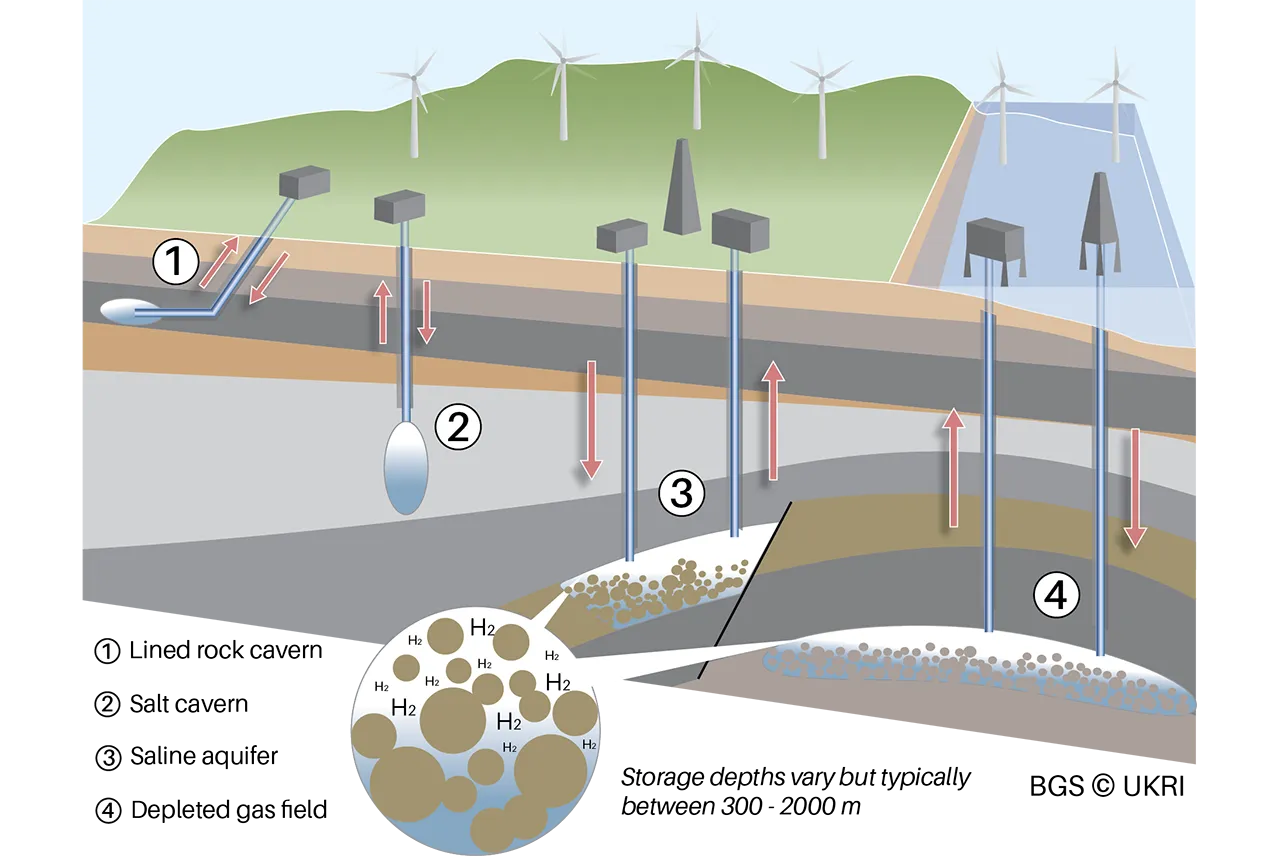Making the case for underground hydrogen storage in the UK
A new BGS science briefing note focuses on the potential of hydrogen storage to support the UK energy transition.
03/04/2025 By BGS Press
BGS briefing notes aim to communicate the latest scientific research in a succinct format to policymakers, industry and the general public. The latest note, ‘Underground hydrogen storage: insights and actions to support the energy transition’, outlines the current state of play in terms of hydrogen storage research and development, and names underground hydrogen storage as an emerging technology that will be crucial to support the UK’s transition to net zero.
As renewable energy sources like wind and solar increase their market share, the need for reliable, long-duration energy storage solutions become increasingly important for enabling a balance between supply and demand. Hydrogen, produced from renewable sources, can act as an effective energy carrier to store excess power as well as an alternative fuel to decarbonise hard-to-abate sectors like shipping and heavy industry.
Various underground storage technologies, such as salt caverns, lined rock caverns and depleted hydrocarbon fields, provide scalable and long-duration hydrogen storage options. Although they require significant initial investment and specific geological conditions, these technologies offer the potential for large-scale, long-duration storage capacities.
Currently, the UK energy storage system holds some of the lowest levels of gas storage in Europe, at 12 days average. Estimates for the hydrogen storage required by net zero in 2050 are up to five times greater than the current UK gas storage capacity, but there are still considerable knowledge gaps in how and where such large-scale storage can be achieved.
The briefing note provides key recommendations in order to close these knowledge gaps:
- implement more demonstration projects to build in situ technical capability, address market barriers and promote wider hydrogen adoption
- integrate hydrogen storage into the UK’s energy strategy through comprehensive planning and supportive regulatory frameworks
- invest in research and development to rapidly expand knowledge in the hydrogen storage technologies essential for meeting clean energy targets
The successful integration of hydrogen storage is key to stabilising the grid and ensuring a reliable hydrogen supply to meet the UK’s climate targets. However, while technology holds great promise, significant investment, research and development are required to address technical and regulatory challenges and the success of large-scale deployment depends on overcoming geological, regulatory and commercial challenges.
Dr Tim Armitage, BGS Geoscientist and author of the briefing note.
More information on BGS’s energy storage research can be found on the website.
Relative topics
Related news

Making research matter: BGS joins leading research organisations in new national initiative
10/12/2025
A new alliance of 35 organisations has been formed that is dedicated to advancing science for the benefit of people, communities, the economy and national priorities.

BGS welcomes publication of the UK Critical Minerals Strategy
23/11/2025
A clear strategic vision for the UK is crucial to secure the country’s long-term critical mineral supply chains and drive forward the Government’s economic growth agenda.

New funding awarded for UK geological storage research
21/11/2025
A project that aims to investigate the UK’s subsurface resource to support net zero has been awarded funding and is due to begin its research.

How the geology on our doorstep can help inform offshore infrastructure design
19/11/2025
BGS is part of a new collaboration using onshore field work to contextualise offshore data and update baseline geological models which can inform the sustainable use of marine resources.

Funding awarded for study on hydrogen storage potential in North Yorkshire
22/09/2025
A new study has been awarded funding to explore the potential for underground hydrogen storage near the Knapton power plant.

New geological ‘pathways’ discovered beneath Welsh capital
02/09/2025
Scientists have discovered cavities in the clay underneath Cardiff, which will influence the siting of future geothermal developments.

New platform highlights geothermal potential across the UK
11/08/2025
A new government-funded geothermal initiative, which includes an interactive map, has launched to help decision makers assess the geothermal potential across the UK.

BGS hosts India for ‘deep dive’ on carbon capture and storage
30/07/2025
Some of India’s top scientists visited BGS to explore the UK’s carbon dioxide storage research potential.

Zambia’s first critical minerals guide supports the country’s potential in global clean energy transition
18/07/2025
A new guide to Zambia’s critical minerals highlights the country’s current and potential critical mineral resources, including cobalt and lithium.

Funding awarded to UK/Canadian critical mineral research projects
08/07/2025
BGS is part of a groundbreaking science partnership aiming to improve critical minerals mining and supply chains.

Goldilocks zones: ‘geological super regions’ set to drive annual £40 billion investment in jobs and economic growth
10/06/2025
Eight UK regions identified as ‘just right’ in terms of geological conditions to drive the country’s net zero energy ambitions.

New interactive map viewer reveals growing capacity and rare earth element content of UK wind farms
16/05/2025
BGS’s new tool highlights the development of wind energy installations over time, along with their magnet and rare earth content.



